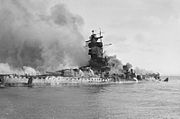Seguro Obrero massacre
This article relies largely or entirely on a single source. (October 2022) |
| Seguro Obrero Masacre | |
|---|---|
| Part of the Santiago de Chile | |
| Result |
Chilean government victory Surrendered rebels massacred |
The Seguro Obrero massacre (Spanish: Matanza del Seguro Obrero, lit. 'Workers Insurance's Massacre') occurred on September 5, 1938, and was the Chilean government's response to an attempted coup d'état by the National Socialist Movement of Chile (MNSCh), whose members were known at the time as Nacistas ("Nazis"). Known for their affinity towards violence in order to attain their goals, their occupation of the central building at the University of Chile and the Seguro Obrero building was responded to quickly and harshly by the Chilean government and the carabineros.[1] After the failed coup, which involved a stand-off and shootout where one Nacista and one police officer (carabinero) were killed, the Nacistas ultimately surrendered after being given assurances of not being harmed. However, the police then broke their promise and summarily executed the Nacistas, allegedly under the orders of President Arturo Alessandri. A total of 59 Nacistas were massacred, with only four of the rebels managing to escape.[2]
Background
The Seguro Obrero Massacre took place on 5 September 1938, in the midst of a heated three-way election campaign between the liberal-conservative Gustavo Ross Santa María, the radical
Coup

At around 12:30 on September 5, 1938, approximately 30 armed Nacista youths affiliated with the National Socialist Movement occupied the Seguro Obrero building. José Luis Salazar, a carabinero (uniformed police) who was on watch, upon observing the situation, thought that the Nacistas were concealing weapons under their coats, and prepared to respond. However, a member of the Nacista movement who observed the reaction of the serviceman opened fire, mortally wounding Salazar.[9]
In response, a short while later a group of carabineros arrived and gathered at the base of the building. Heavy fire was exchanged between the Nacistas and the carabineros. Gerald Gallmeyer, a Nacista youth, was killed. His companions continued to resist and attempt to hold the building, but the carabineros ultimately forced them to retreat to the top floor,where they disabled the elevators and barricaded themselves in.[10]
In the meantime, another 32 Nacista youths had occupied the central building at the University of Chile. This culminated in a shoot-out as well, beginning at 02:00, when an assault by the carabineros took members of the National Socialist group by surprise; those who surrendered were led with their hands up, toward the Seguro Obrero a few blocks away. There they were informed that the attempted coup had already failed and were sent into the building to convince their companions to lay down their arms on the condition that their lives would be spared. The Nacista activists accepted these terms and surrendered.[9]
However, the police abruptly broke their promise and massacred the Nacistas. According to a reporter who was hiding in the Seguro Obrero building basement during the standoff, the carabineros opened fire on the Nacistas before they had even exited the building. The officers seemingly went from room to room to eliminate the Nacistas who had already surrendered and laid down their weapons, lining them up against walls and mowing them down with rifle fire.[11] Their bodies and faces were mutilated with sabers and bayonets.[12] Ultimately, the police executed 59 Nacistas, with only four youths managing to escape.[11]
Still a topic of debate to this day, some attested that Arturo Alessandri, enraged by the coup and looking to past success of forcefully putting down troublesome groups, issued presidential orders to the Carabinero General Arriagada to eliminate the Nacista threat by 1600 that day or the military and artillery would take over.[12] Although the accusations are grounded in speculation, it is argued by Marcus Klein in La Matanza del Seguro Obrero, and accepted by many historians that Alessandri gave the execution order.[13] Although he denied this even to his deathbed, claiming to have only told Arriagada to restore order however he best saw fit.[14]
See also
- Ariostazo
- Chilean political scandals
- History of Chile
- List of massacres in Chile
- Operation Bolivar
- World War II by country#Chile
References
This article needs additional citations for verification. (September 2011) |
- ^ Sznajder, Mario (1993). "A Case of Non-European Fascism: Chilean National Socialism in the 1930s". Journal of Contemporary History. 28 (2): 269–296 – via JSTOR.
- ISSN 0717-7194.
- ^ Friedman, Max (2003). Nazis and Good Neighbours. Cambridge University.
- ^ Payne, Stanley (2001). A History of Fascism: 1914–1945. London: Routledge.
- ^ Sznajder, Mario (1993). "A Case of Non-European Fascism: Chilean National Socialism in the 1930s". Journal of Contemporary History. 28 (2): 269–296 – via JSTOR.
- ^ "El "nunca más" a través de la historia – La Masacre del Seguro Obrero". Revista Punto Final. 10 October 2003. Retrieved 3 August 2009.
- ^ Super, Richard (1977). Masterson, Daniel M; Bratzel, John F (eds.). The Underside of Latin American History. Latin American Studies Center, Michigan State University. pp. 49–50.
- ^ Super, Richard (1977). Masterson, Daniel M; Bratzel, John F (eds.). The Underside of Latin American History. Latin American Studies Center, Michigan State University. pp. 61–62.
- ^ S2CID 146444478.
- ^ Super, Richard (1977). Masterson, Daniel M; Bratzel, John F (eds.). The Underside of Latin American History. Latin American Studies Center, Michigan State University. pp. 51–52.
- ^ a b Super, Richard (1977). "The Seguro Obrero Massacre". The Underside of Latin American History: 53.
- ^ a b Super, Richard (1977). Masterson, Daniel M; Bratzel, John F (eds.). The Underside of Latin American History. Latin American Studies Center, MSU. p. 53.
- ISSN 0022-216X.
- ^ Super, Richard (1977). Masterson, Daniel M; Bratzel, John F (eds.). The Underside of Latin American History. Latin American Studies Center, Michigan State University. p. 62.
External links

